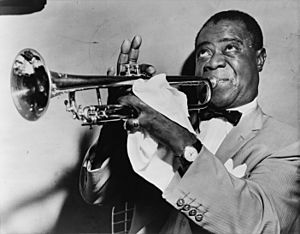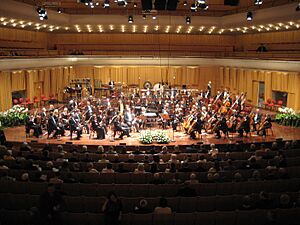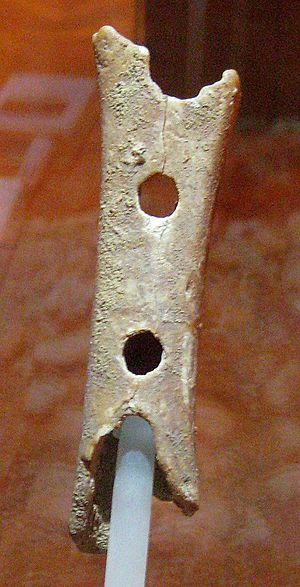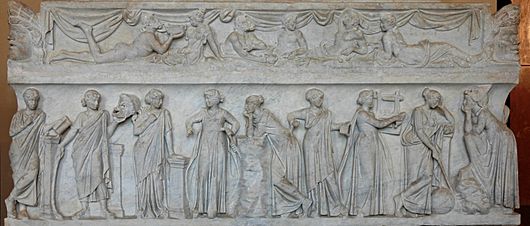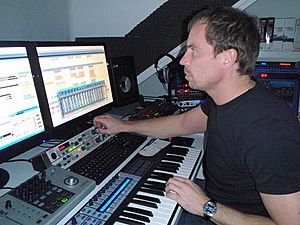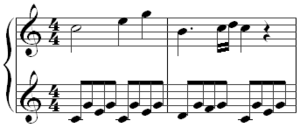Music facts for kids
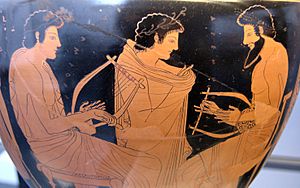
Music is a special way of putting sounds together. People often find these sounds interesting or enjoyable. Most music involves people singing with their voices. It also includes playing musical instruments. Common instruments are the piano, guitar, or drums.
The word music comes from the Greek word μουσική (mousike). This means "(art) of the Muses." In Ancient Greece, the Muses were goddesses. They inspired music, poetry, art, and dance. Someone who creates music is called a musician.
Contents
What is Music?

Music is sound that has been organized. It uses things like rhythm, melody, or harmony. If you bang saucepans while cooking, it just makes noise. But if you bang them in a steady, repeating way, you are making a simple kind of music.
Music usually has four main parts:
- Music often has pitch. This means high and low notes. Tunes are made of notes that move up, down, or stay the same.
- Music often has rhythm. Rhythm is how musical sounds and silences are put together. Every tune has a rhythm you can tap along to. Music usually has a regular beat.
- Music often has dynamics. This means how quiet or loud the music is. It can be very soft, very loud, or somewhere in between.
- Music often has timbre. This is a French word (pronounced "TAM-br"). Timbre is what makes a sound unique and interesting. It describes the quality of a sound. For example, it's what makes a clarinet sound different from an oboe. It also makes one person's voice sound different from another's.
History of Music
People have been making music since the Stone Age. The first music probably copied sounds and rhythms from nature. Early human music might have used patterns and repetition. This kind of music still exists today. Some shamans imitate sounds from nature. Music can also be for entertainment or for practical uses. For example, it might have helped hunting by luring animals.
Some animals also use sounds in musical ways. Songbirds use song to protect their territory. They also sing to attract a mate. Monkeys have been seen beating hollow logs. This might also be to defend their territory.
The first musical instrument used by humans was likely the voice. The human voice can make many different sounds. The larynx (voice box) works like a wind instrument. Scientists found an old Neanderthal hyoid bone in 1983. This bone supports the voice box. It suggests Neanderthals could use language.
The first rhythm instruments were likely clapping hands. People also hit stones together. These helped keep a beat. Some very old finds from the paleolithic era could be tools or musical instruments.
The First Flutes
The oldest discovered flute might be the Divje Babe flute. It was found in Slovenia in 1995. It is a piece of a cave bear's femur. It is about 43,000 years old. However, some people still debate if it was truly a musical instrument.
In 2008, archaeologists found a bone flute in Hohle Fels cave in Germany. This flute has five holes and a V-shaped mouthpiece. It was made from a vulture wing bone. Scientists published their findings in 2009. This is the oldest confirmed musical instrument ever found. Other flutes were also found nearby. This flute was found near the Venus of Hohle Fels, an ancient human carving.
Scientists believe these finds show a strong musical tradition. This tradition existed when modern humans first came to Europe.
The oldest known wooden pipes were found in Ireland in 2004. They were six flutes made from yew wood. They were 30 to 50 cm long. They had no finger holes. They might have been tied together.
In 1986, several bone flutes were found in Jiahu, China. They are about 8,000 years old. They have 5 to 8 holes. They were made from the bones of a Red-crowned crane. One was still playable when found. These flutes could play ancient Chinese musical scales.
| Periods in Music History | Dates |
|---|---|
| Prehistoric music Ancient music Medieval music Renaissance music Baroque music Classical music period Romantic music |
(before writing) (before 350 AD) About 350–1400 1400–1600 1600–1750 1740–1820 |
Ancient Times
We do not know what the earliest music sounded like. Old architecture and paintings exist. But old music could not survive until people wrote it down. We can guess about early music from old paintings. These show people playing instruments. We also find instruments in archaeological digs. The oldest written music found is from about 1500 BC. It was on a tablet in Hurrian, a language from Mesopotamia (modern Iraq).
Middle Ages
Another old piece of written music is a round called Sumer Is Icumen In. A monk wrote it down around 1250. Much music in the Middle Ages (about 450-1420) was folk music. Working people played it for singing or dancing. Most written music from this time was for the Catholic Church. This music was called Chant, or Gregorian chant. Monks sang it in church.
Renaissance
The Renaissance (about 1400-1550) was a time of much music. Many composers wrote music that we still perform today. "Renaissance" is a French word meaning "rebirth." This period was a "rebirth" for many types of art and music.
Giovanni da Palestrina (1525-1594) wrote beautiful church music. In Palestrina's music, many singers sing together in a choir. There was also non-church music. This included happy dance music and romantic love songs. Popular instruments were viols (bowed string instruments), lutes (like a guitar), and the virginal (a small keyboard instrument).
Baroque Period
The Baroque period in Western culture started around 1600 in Rome. It was known for drama and grandeur in art and music. In music, it was a time when different voices and instruments would echo each other. They would play similar tunes but at different pitches.
The Roman Catholic Church encouraged the Baroque style. They wanted art to show religious themes in an emotional way. Wealthy people also used this dramatic style. It helped them impress visitors and show their power. Baroque palaces had grand entrances and rooms. Similarly, Baroque art and music had many details. Artists explored creating from repeated and varied patterns.
The word "baroque" likely comes from a Portuguese word. It meant a pearl that was not perfectly round. So, "baroque" can also mean something "elaborate" or with many details.
Classical Period
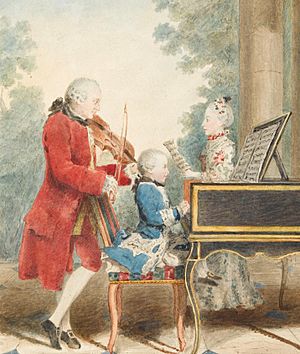
In Western music, the Classical period was from about 1750 to 1825. This was the time of composers like Joseph Haydn, Wolfgang Amadeus Mozart, and Ludwig van Beethoven. Orchestras grew larger. Composers wrote longer pieces called symphonies. Symphonies had several sections called movements. Some movements were loud and fast. Others were quiet and sad.
The form of music was very important then. Music had to have a nice "shape." Composers often used a structure called sonata form. Another important type of music was the string quartet. This is for two violins, a viola, and a cello. Like symphonies, string quartets had several sections. Haydn, Mozart, and Beethoven wrote many famous string quartets.
The piano was invented during this time. Composers liked it because it could play different dynamics. It could get louder or softer. Other popular instruments included the violin, cello, flute, clarinet, and oboe.
Romantic Period
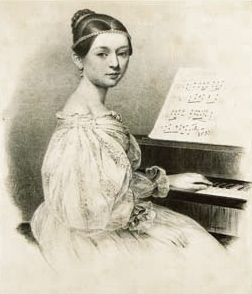
The 19th century is called the Romantic period. Composers wanted to show their emotions through music. The piano was a very important instrument. Some composers, like Frédéric Chopin, wrote quiet, emotional piano pieces. Music often described feelings or told stories with sounds.
Other composers, like Franz Schubert, wrote songs called Lied (German for "song"). These Lieder (plural) told stories using lyrics (words) and imaginative piano accompaniments. Composers like Richard Strauss and Franz Liszt told stories using only music. This was called a tone poem. Franz Liszt and Johannes Brahms used the piano for loud, dramatic, emotional music.
Many composers wrote for bigger orchestras, sometimes with 100 instruments. This was also a time of "Nationalism." Composers showed pride in their country. They used folksongs or melodies from their homelands. Famous composers from this time include Franz Schubert, Felix Mendelssohn, Frédéric Chopin, Johannes Brahms, Pyotr Ilyich Tchaikovsky, and Richard Wagner.
Modern Times
The "modern period" started around 1900. Many 20th century composers wanted new sounds. They explored new instruments, forms, sounds, or harmonies.
The composer Arnold Schoenberg (1874-1951) wrote atonal pieces. These did not sound like they were in a clear musical key. Later, Schoenberg created the twelve-tone system. Music written with this system can sound unusual. It is often mathematical and needs careful study. Pure twelve-tone music was popular with academics in the 1950s and 60s. Some composers still use it for specific effects.
Igor Stravinsky (1882-1971) was an important 20th-century composer. He wrote music with complex chords and rhythms. Some composers felt music was getting too complicated. So, they wrote Minimalist pieces using very simple ideas. In the 1950s and 1960s, composers like Karlheinz Stockhausen tried electronic music. They used electronic circuits, amplifiers, and loudspeakers. In the 1970s, composers started using electronic synthesizers. They also used instruments from rock and roll, like the electric guitar. These new instruments made new sounds.
Composers in the 1990s and 2000s mix these ideas. John Adams (born 1947) and James MacMillan (born 1959) often write tonal music. They also like to use easy tunes.
Electronic Music
Music can be made using electronics. This is often done with computers, keyboards, electric guitars, and disk tables. These can copy traditional instruments. They can also make completely new sounds. Today, electronic music is often made with computer programs and hardware mixers.
Jazz
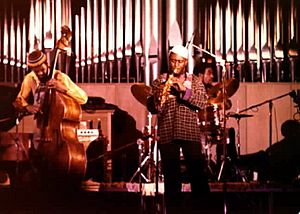
Jazz music began around 1900 in New Orleans, USA. Many black musicians lived there. They played a style called blues music. Blues music was influenced by African music. This was because black people were brought to the United States from Africa. Blues songs often had sad lyrics about difficult feelings or experiences.
Jazz music combined blues music with European music. Some black composers like Scott Joplin wrote ragtime. Ragtime had a unique rhythm. It influenced early jazz, called Dixieland jazz. Jazz musicians used instruments like the trumpet, saxophone, and clarinet for melodies. Drums were for percussion. Plucked double bass, piano, banjo, and guitar made up the rhythm section.
Jazz is usually improvised. Players make up the music as they go. Even so, jazz music has rules. Musicians play a series of chords (groups of notes) in a certain order.
Jazz music has a "swinging" rhythm. This rhythm feels natural and relaxed. It is not stiff like a march. It has a long-short feel. A "swinging rhythm" also excites listeners. When a jazz band plays well together, people say "that band really swings well."
Jazz influenced other music, like Western art music in the 1920s and 1930s. Composers like George Gershwin wrote jazz-influenced music. Jazz also influenced pop music songs. In the 1930s and 1940s, many pop songs used jazz chords or melodies. Louis Armstrong (1900-1971) was one of the most famous jazz musicians.
Pop Music
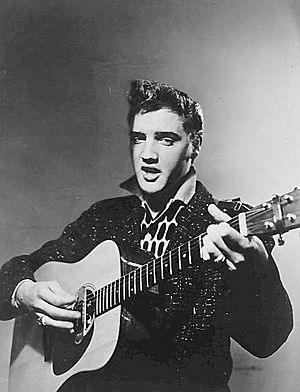
"Pop" music is a type of popular music. Many people enjoy listening to it. The term "pop music" has been used since about 1880. It described music that was widely liked.
Modern pop music grew from 1950s rock and roll. Examples include Chuck Berry and Elvis Presley. In the 1960s, The Beatles became a famous pop group. In the 1970s, other styles mixed with pop. These included funk and soul music. Pop music usually has a strong beat. This makes it good for dancing. Pop singers often use microphones connected to amplifiers and loudspeakers.
Musical Notation
"Musical notation" is how music is written down. Writing music down helps save it. It also helps people remember it for future performances. This way, composers (people who write music) can show others how to play their pieces.
Solfège
Solfège (also called solfa) is a way to name musical tones. It gives names to different pitches. For example, the eight basic notes "Do, Re, Mi, Fa, So, La, Ti, Do" are the names for the notes of the major scale.
Written Music
Music can be written in several ways. When written on a staff (like the example shown), pitches and their length are shown by symbols. These symbols are called notes. Notes are placed on the lines and in the spaces. Each position tells you which tone to play. Higher notes on the staff mean higher pitches. Lower notes mean lower pitches. The length of notes is shown by making the note "heads" black or white. They also have stems and flags.
Music can also be written with letters. These letters name the notes, like in solfa "Do, Re, Mi, Fa, So, La, Ti, Do." Or they can be represented by letters like C, D, E. The table below shows how solfa notes are represented in Standard Notation:
| Solfa Name | Standard Notation |
|---|---|
| Do | C |
| Re | D |
| Mi | E |
| Fa | F |
| Sol | G |
| La | A |
| Ti | B |
Standard Notation makes reading music easier. It is often used for chords and music scales. These ways of writing music help people read it. There are other ways to write music, but they are less common or more complex.
How to Enjoy Music
By Listening
People can enjoy music by listening. They can go to concerts to hear musicians. Classical music is usually performed in concert halls. But sometimes large festivals are held outdoors. People can listen to music on CDs, computers, iPods, television, radio, and mobile phones.
Music is everywhere today. It plays in elevators, shopping malls, and stores. Often, it becomes background noise. Sometimes it's good to listen closely. Try to hear the different instruments. Notice what kinds of notes they are playing.
By Playing or Singing
People can learn to play an instrument. For beginners, the piano or keyboard is common. The guitar or recorder are also good choices. Recorders are very cheap to buy. After learning scales and simple tunes, you can read basic musical notation. Then you can choose an instrument for more learning.
Choose an instrument that fits your size. For example, a short child cannot play a full-size double bass. It is over five feet tall. Choose an instrument you enjoy playing. Playing regularly is the only way to get better. Finally, a good teacher can help a lot.
By Composing
Anyone can create their own music. It is not hard to compose simple songs or melodies. It is easier if you can play an instrument. All it takes is trying out sounds an instrument makes. You can create a piece that tells a story. Or you can find a nice tune and change it each time it repeats. Your own voice can also be an instrument.
Related pages
Images for kids
-
Grooved side of the Voyager Golden Record launched along the Voyager probes to space, which feature music from around the world
-
The piano was the centrepiece of social activity for middle-class urbanites in the 19th century (Moritz von Schwind, 1868). The man at the piano is composer Franz Schubert.
-
Assyrians playing zurna and Davul, instruments that go back thousands of years.
-
Improvisation plays a central role in jazz; musicians learn progressions using scale and chord tones (Pictured is Johnny Hodges)
-
Khatia Buniatishvili playing a grand piano
-
The melody to the traditional song "Pop Goes the Weasel"
-
When musicians play three or more different notes at the same time, this creates a chord. In Western music, including classical music, pop music, rock music, and many related styles, the most common chords are triads– three notes usually played at the same time. The most commonly used chords are the major chord and the minor chord. An example of a major chord is the three pitches C, E and G. An example of a minor chord is the three pitches A, C, and E. (Pictured is a guitar player performing a chord on a guitar).
-
19th-century composer and pianist Clara Schumann
-
Ethnomusicologist Frances Densmore recording Blackfoot chief Mountain Chief for the Bureau of American Ethnology (1916)
See also
 In Spanish: Música para niños
In Spanish: Música para niños


